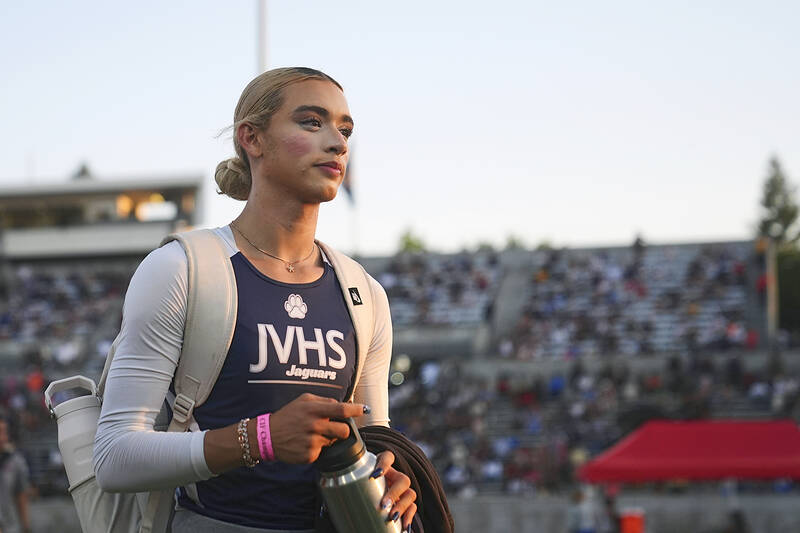California’s high school track-and-field state championships kicked off on Friday in the sweltering heat to a relatively quiet atmosphere despite controversy leading up to the meet over the participation of a transgender athlete.
The meet is the testing ground for a new participation and medaling policy for competitions that include transgender athletes.
The California Interscholastic Federation (CIF) let an additional student compete and potentially offer an extra medal in three events in which a trans athlete is competing. The athlete, high school junior AB Hernandez, is the second seed in the triple jump, and is also participating in the long jump and high jump.

Photo: AP
A small protest of fewer than 10 people, including parents, gathered outside the stadium to oppose Hernandez’s participation. Some of them wore “Save Girls’ Sports” T-shirts.
It was quiet inside the stadium before the long jump and high jump events began, but once Hernandez started her events, a couple of isolated protests occurred. At one point, as she was attempting a high jump, someone in the stands yelled an insult. An aircraft circled above the stadium for more than an hour during the events, carrying a banner that read, “No Boys in Girls’ Sports!”
It might be the first effort by a high school sports governing body to expand participation when trans athletes are participating, and it reflects efforts to find a middle ground in the debate over trans girls’ participation in youth sports.
“The CIF values all of our student-athletes and we will continue to uphold our mission of providing students with the opportunity to belong, connect, and compete while complying with California law,” the group said in a statement after announcing its rule change.
State law allows trans students to compete on sex-segregated sports teams consistent with their gender identity.
US President Donald Trump threatened this week to pull federal funding from California unless it bars trans female athletes from competing on girls’ teams. The US Department of Justice also said it would investigate the state federation and the district that includes Hernandez’s high school to determine whether they violated federal sex discrimination law by allowing trans girls to compete in girls’ sports.
The meet, which is taking place at a high school near Fresno, California, opened the girls triple jump, long jump and high jump to one additional athlete each who would have qualified had Hernandez not participated. Hernandez led in the long jump in the preliminaries on Friday with a mark close to 6m to advance to the final yesterday. She also advanced in the high jump, clearing 1.7m with ease. In the triple jump, she finished with a mark close to 13m, nearly 25cm ahead of her closest competitor.
Under the pilot policy, if a transgender athlete medals, their ranking would not displace a “biological female” student from medaling, the federation said.
The federation said the rule would open the field to more “biological female” athletes. One expert said the change may itself be discriminatory because it creates an extra spot for “biological female” athletes, but not for other trans athletes.
The federation did not specify how they define “biological female,” or how they would verify whether a competitor meets that definition.
Medical experts say gender is a spectrum, not a binary structure consisting of only males and females.
The two-day meet is expected to draw attention from a coalition of protesting parents and students. Critics have objected Hernandez’s participation and heckled her in qualifying events last month. Leaders from the conservative California Family Council joined Republican state lawmakers on Thursday for a press conference blasting the policy change and saying Hernandez should not be allowed to compete.
CIF executive director Ron Nocetti urged participants and bystanders to behave respectfully toward all student-athletes in a message shared in the championship program.
A recent AP-NORC poll found that about seven in 10 US adults think transgender female athletes should not be allowed to participate in girls and women’s sports at the high school, college or professional level. That view was shared by about nine in 10 Republicans and roughly half of Democrats.
Hernandez told the Capital and Main earlier this month that she could not worry about critics.
“I’m still a child, you’re an adult, and for you to act like a child shows how you are as a person,” she said.
She noted that she has lost some of her events, saying that disproved arguments that she cannot be beaten.
Hernandez has a personal best of more than 12.5m in the triple jump. That is more than 1m short of a national record set in 2019. She is the fifth seed in the long jump, but ranked much lower in the high jump.
California’s state championship stands out from that of other states because of the number of competitors athletes are up against to qualify.
More than 57,000 high schoolers participated in outdoor track and field in California during the last school year, according to a survey by the National Federation of State High School Associations. California had the second-largest number of high school outdoor track-and-field athletes, behind only Texas.
Of the 12 high school athletes who have set national records in the girls’ triple jump between 1984 and 2019, eight have been from California, according to the national sports governing body.
Olympians Marion Jones and Tara Davis-Woodhall previously set state championship records in the long jump in 1993 and 2017, respectively, both surpassing 6.7m.
Davis Whitfield, the national federation’s chief operating officer, called a state championship “the pinnacle” for high school student-athletes.
“It’s certainly a once-in-a-lifetime experience in some cases to participate in a state championship event,” he said.

Taiwan Semiconductor Manufacturing Co (TSMC, 台積電) has secured three construction permits for its plan to build a state-of-the-art A14 wafer fab in Taichung, and is likely to start construction soon, the Central Taiwan Science Park Bureau said yesterday. Speaking with CNA, Wang Chun-chieh (王俊傑), deputy director general of the science park bureau, said the world’s largest contract chipmaker has received three construction permits — one to build a fab to roll out sophisticated chips, another to build a central utility plant to provide water and electricity for the facility and the other to build three office buildings. With the three permits, TSMC

RUN IT BACK: A succesful first project working with hyperscalers to design chips encouraged MediaTek to start a second project, aiming to hit stride in 2028 MediaTek Inc (聯發科), the world’s biggest smartphone chip supplier, yesterday said it is engaging a second hyperscaler to help design artificial intelligence (AI) accelerators used in data centers following a similar project expected to generate revenue streams soon. The first AI accelerator project is to bring in US$1 billion revenue next year and several billion US dollars more in 2027, MediaTek chief executive officer Rick Tsai (蔡力行) told a virtual investor conference yesterday. The second AI accelerator project is expected to contribute to revenue beginning in 2028, Tsai said. MediaTek yesterday raised its revenue forecast for the global AI accelerator used

The DBS Foundation yesterday announced the launch of two flagship programs, “Silver Motion” and “Happier Caregiver, Healthier Seniors,” in partnership with CCILU Ltd, Hondao Senior Citizens’ Welfare Foundation and the Garden of Hope Foundation to help Taiwan face the challenges of a rapidly aging population. The foundation said it would invest S$4.91 million (US$3.8 million) over three years to foster inclusion and resilience in an aging society. “Aging may bring challenges, but it also brings opportunities. With many Asian markets rapidly becoming super-aged, the DBS Foundation is working with a regional ecosystem of like-minded partners across the private, public and people sectors

BREAKTHROUGH TECH: Powertech expects its fan-out PLP system to become mainstream, saying it can offer three-times greater production throughput Chip packaging service provider Powertech Technology Inc (力成科技) plans to more than double its capital expenditures next year to more than NT$40 billion (US$1.31 billion) as demand for its new panel-level packaging (PLP) technology, primarily used in chips for artificial intelligence (AI) applications, has greatly exceeded what it can supply. A significant portion of the budget, about US$1 billion, would be earmarked for fan-out PLP technology, Powertech told investors yesterday. Its heavy investment in fan-out PLP technology over the past 10 years is expected to bear fruit in 2027 after the technology enters volume production, it said, adding that the tech would